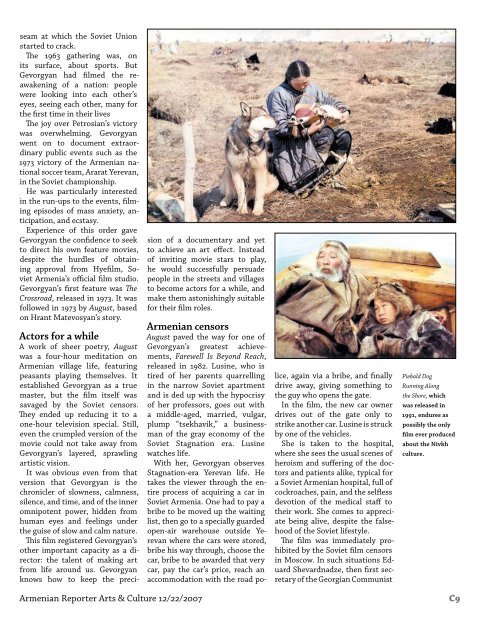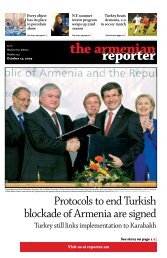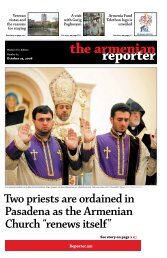Mihran's Mafia Style - Armenian Reporter
Mihran's Mafia Style - Armenian Reporter
Mihran's Mafia Style - Armenian Reporter
Create successful ePaper yourself
Turn your PDF publications into a flip-book with our unique Google optimized e-Paper software.
seam at which the Soviet Union<br />
started to crack.<br />
The 1963 gathering was, on<br />
its surface, about sports. But<br />
Gevorgyan had filmed the reawakening<br />
of a nation: people<br />
were looking into each other’s<br />
eyes, seeing each other, many for<br />
the first time in their lives<br />
The joy over Petrosian’s victory<br />
was overwhelming. Gevorgyan<br />
went on to document extraordinary<br />
public events such as the<br />
1973 victory of the <strong>Armenian</strong> national<br />
soccer team, Ararat Yerevan,<br />
in the Soviet championship.<br />
He was particularly interested<br />
in the run-ups to the events, filming<br />
episodes of mass anxiety, anticipation,<br />
and ecstasy.<br />
Experience of this order gave<br />
Gevorgyan the confidence to seek<br />
to direct his own feature movies,<br />
despite the hurdles of obtaining<br />
approval from Hyefilm, Soviet<br />
Armenia’s official film studio.<br />
Gevorgyan’s first feature was The<br />
Crossroad, released in 1973. It was<br />
followed in 1973 by August, based<br />
on Hrant Matevosyan’s story.<br />
Actors for a while<br />
A work of sheer poetry, August<br />
was a four-hour meditation on<br />
<strong>Armenian</strong> village life, featuring<br />
peasants playing themselves. It<br />
established Gevorgyan as a true<br />
master, but the film itself was<br />
savaged by the Soviet censors.<br />
They ended up reducing it to a<br />
one-hour television special. Still,<br />
even the crumpled version of the<br />
movie could not take away from<br />
Gevorgyan’s layered, sprawling<br />
artistic vision.<br />
It was obvious even from that<br />
version that Gevorgyan is the<br />
chronicler of slowness, calmness,<br />
silence, and time, and of the inner<br />
omnipotent power, hidden from<br />
human eyes and feelings under<br />
the guise of slow and calm nature.<br />
This film registered Gevorgyan’s<br />
other important capacity as a director:<br />
the talent of making art<br />
from life around us. Gevorgyan<br />
knows how to keep the precision<br />
of a documentary and yet<br />
to achieve an art effect. Instead<br />
of inviting movie stars to play,<br />
he would successfully persuade<br />
people in the streets and villages<br />
to become actors for a while, and<br />
make them astonishingly suitable<br />
for their film roles.<br />
<strong>Armenian</strong> censors<br />
August paved the way for one of<br />
Gevorgyan’s greatest achievements,<br />
Farewell Is Beyond Reach,<br />
released in 1982. Lusine, who is<br />
tired of her parents quarrelling<br />
in the narrow Soviet apartment<br />
and is ded up with the hypocrisy<br />
of her professors, goes out with<br />
a middle-aged, married, vulgar,<br />
plump “tsekhavik,” a businessman<br />
of the gray economy of the<br />
Soviet Stagnation era. Lusine<br />
watches life.<br />
With her, Gevorgyan observes<br />
Stagnation-era Yerevan life. He<br />
takes the viewer through the entire<br />
process of acquiring a car in<br />
Soviet Armenia. One had to pay a<br />
bribe to be moved up the waiting<br />
list, then go to a specially guarded<br />
open-air warehouse outside Yerevan<br />
where the cars were stored,<br />
bribe his way through, choose the<br />
car, bribe to be awarded that very<br />
car, pay the car’s price, reach an<br />
accommodation with the road police,<br />
again via a bribe, and finally<br />
drive away, giving something to<br />
the guy who opens the gate.<br />
In the film, the new car owner<br />
drives out of the gate only to<br />
strike another car. Lusine is struck<br />
by one of the vehicles.<br />
She is taken to the hospital,<br />
where she sees the usual scenes of<br />
heroism and suffering of the doctors<br />
and patients alike, typical for<br />
a Soviet <strong>Armenian</strong> hospital, full of<br />
cockroaches, pain, and the selfless<br />
devotion of the medical staff to<br />
their work. She comes to appreciate<br />
being alive, despite the falsehood<br />
of the Soviet lifestyle.<br />
The film was immediately prohibited<br />
by the Soviet film censors<br />
in Moscow. In such situations Eduard<br />
Shevardnadze, then first secretary<br />
of the Georgian Communist<br />
Piebald Dog<br />
Running Along<br />
the Shore, which<br />
was released in<br />
1991, endures as<br />
possibly the only<br />
film ever produced<br />
about the Nivkh<br />
culture.<br />
<strong>Armenian</strong> <strong>Reporter</strong> Arts & Culture 12/22/2007<br />
C9

















